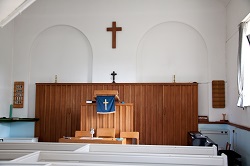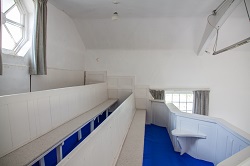Weston Turville Union Chapel is a grade 2 listed building inside and out. That makes maintenance and repair more difficult and severely restricts any changes to the building, but Historic England say it one of the few ‘original’ preaching houses built in that era.
It was erected in 1839 on farmland given by Mr John Munger who farmed the nearby Manor Farm. He placed the building in the hands of ‘twelve good men and true’ as trustees. The chairman was his own brother Robert who farmed at Butlers Cross. It was recorded that in 1840, the Deeds were enrolled in Aylesbury’s Court of Chancery. There are no minutes to tell us of the first years of work, and sixteen years were to pass before fourteen members formed themselves into a church on 4th February 1856.
The trust Deed laid down that the Chapel was for the use of Baptists and Independents. This was interpreted to mean that applicants for membership could state whether they wished to join by the way of baptism or by verbal confession of their faith. The Deeds also stated that if any time the work of the Chapel should cease, the proceeds of the sale of the property should be shared between the Baptist Union and the Congregational Union. This stipulation explains the term ‘Union Chapel’. Beyond this legal stipulation, the Congregationalists never seemed to have had any official connection to the Chapel.

In 1856 the Chapel was in the Pastoral care of Reverend E Edwards. To accommodate the growing congregation, the Reverend Edwards arranged for the installation of the gallery which was added in 1856 and following requests from the congregation, a Baptistry was added which was opened on 29th April 1864.

In 1865 the first elders of the Chapel were appointed; they were John Bunce and John Clark.
A licence to conduct marriages was granted in 1881.
In the early days of the Chapel, transport and communication was limited. Preachers without a horse were required to walk to Weston Turville and it was not unusual for a Preacher to walk from Quainton to deliver his sermon. By 1905 the Chapel required renovation at a cost of £18. It was decided to undertake the renovation work and to build a schoolroom which incorporated a Ministers Vestry, at the rear. A boundary wall and iron fence was also erected to surround the burial ground. The opening ceremony for the new schoolroom and building works was conducted by Mr John Munger, a descendant of the original benefactor who gave the land for the Chapel to be built on.

In 1906 the Baptist Union of Great Britain became Trustees by Resolution of the Members.
Since then the Chapel has seen many ups and downs. It is still completely self financing and and is organised and run by the congregation themselves. One of the congregation has worshipped here for about 60 years. The building didn’t ever fall into neglect, but the present congregation are bringing it back to its ‘best loved’ state. Over the last few years there have been significant repairs made to the roof. The windows have also been repaired (Historic England vetoed the original looking but modern equivalents) and the outside of the building painted. More work is going to be done sprucing up inside and converting the existing toilets to a single disabled access toilet.
Perhaps the building reflects the congregation. In some ways it changes to suit the needs of the Sunday congregation and the many people who use the building during the week, but in others it is unwavering and stands firm. The present congregation celebrated the building’s 175th anniversary and are looking forward to the 350th – although they accept it is unlikely they will be able to attend themselves.
